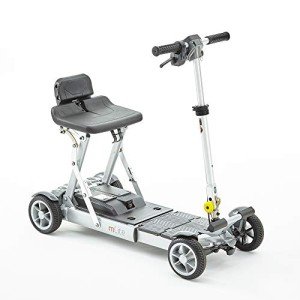Understanding Mobility Devices: Enhancing Independence and Quality of Life
In today's fast-paced world, the desire for mobility is universal. Nevertheless, certain medical conditions or age-related difficulties can prevent motion, leading to a continuous search for assistance. Mobility devices work as vital tools to improve self-reliance, improve lifestyle, and enable people to engage fully in their communities. This post offers a detailed summary of mobility devices, including their types, functions, choice criteria, and more.
Types of Mobility Devices
Mobility devices range from simple aids to complicated equipment, customized to fulfill different needs. Below is a table summing up typical types of mobility devices:
| Type of Device | Description | Suitable For |
|---|---|---|
| Walkers | Four-legged support devices that supply remarkable stability while walking. | Individuals requiring additional support. |
| Canes | Single or three-legged sticks that enhance balance and support walking. | Those with minor mobility problems. |
| Wheelchairs | Seats mounted on wheels, offered in handbook and electric variations. | Individuals with minimal or no mobility. |
| Scooters | Electric lorries designed for outdoor use and ease of navigation. | Those who can't stroll cross countries. |
| Crutches | Devices that assist people transfer weight away from an injured leg. | People recuperating from leg injuries. |
| Rollators | Walkers with wheels, seats, and brakes for improved mobility. | Users needing rest options while walking. |
| Lift Chairs | Reclining chairs that help users in standing and sitting down. | Seniors or those with mobility constraints. |
| Mobility Scooters | Small electric vehicles for restricted mobility, typically utilized outdoors. | People needing support over cross countries. |
Key Features of Mobility Devices
When choosing a mobility gadget, a number of key features should be thought about to guarantee optimum performance and ease of usage:
- Weight Capacity: Understanding the gadget's weight limitation is vital for safety and effectiveness.
- Adjustability: Devices needs to be adjustable in height and width to fit the user easily.
- Mobility: Lightweight and foldable options are important for users who travel or require transportation.
- Stability and Safety: Look for features like anti-tip wheels and durable structures to boost safety.
- Ease of Use: Simple systems and easy to use designs can make a significant distinction in day-to-day use.
- Convenience: Ergonomic styles and padded seats can boost the user experience.
Choosing the Right Mobility Device
Selecting the right mobility device can be a challenging task. Here are some actions to guide the decision-making procedure:
- Assess Needs: Evaluate the individual's mobility difficulties and everyday activities.
- Seek advice from a Professional: Engage health care experts who can offer recommendations based on the individual's physical condition.
- Trial Options: If possible, trial different devices to determine convenience and functionality.
- Evaluation Budget: Consider the expense of the device, including any extra functions or modifications required.
- Research Options: Determine the best brand names and models by reading reviews and comparisons.
Table: Comparative Analysis of Popular Mobility Devices
| Device | Benefits | Drawbacks |
|---|---|---|
| Walkers | Exceptional stability, promotes strolling. | Bulky, may restrict movement in small areas. |
| Walking canes | Lightweight, boosts balance. | May not offer enough support for extreme mobility issues. |
| Wheelchairs | Perfect for those with considerable mobility limitations. | Can be cumbersome, especially in indoor environments. |
| Scooters | Great for outdoor use, simple to maneuver. | Limited indoor use, heavier. |
| Rollators | Provides rest alternative, simple to move. | May require more area than conventional walkers. |
| Lift Chairs | Comfortable, helps transition from sitting to standing. | More expensive, bigger footprint. |
Regularly Asked Questions (FAQs)
1. What is a mobility gadget?
A mobility device is any tool designed to assist people in moving and browsing their environment. This consists of walkers, wheelchairs, scooters, and crutches.
2. How do I know which mobility device is best for me?
Consider your particular mobility challenges, physical capabilities, and way of life needs. Consulting with healthcare experts can likewise supply customized recommendations.
3. Are mobility devices covered by insurance coverage?
Numerous insurance plans, including Medicare, might cover particular mobility devices. It's essential to talk to your insurance provider for particular protection details.
4. Can I rent a mobility gadget instead of purchasing one?
Yes, many medical supply shops and drug stores use rentals for mobility devices. This alternative is helpful for individuals with short-lived mobility issues.
5. How can I keep my mobility device?
Regular maintenance is important. It includes cleaning up the device, examining for wear and tear, and guaranteeing all parts are functioning properly.
The Impact of Mobility Devices on Quality of Life
Mobility devices substantially enhance the quality of life for people with minimal mobility. They cultivate independence, motivate social interaction, and enhance access to important services and recreational activities.
- Increased Independence: Users can browse their neighborhoods, attend events, and participate in hobbies without depending on others.
- Social Engagement: Mobility devices assist in involvement in social gatherings, thus combating feelings of isolation.
- Improved Safety: Devices supply stability and lower the danger of falls, promoting user self-confidence.
Mobility devices are more than just tools for motion; they are entrances to independence and quality living. By comprehending the various types of mobility aids available, their key functions, and factors to consider for choosing the right device, individuals can make educated decisions about their mobility requires. Eventually, the best mobility gadget can result in a more active, fulfilling life. Whether compact mobility scooters 's a walker, wheelchair, or scooter, the ideal option contributes significantly to improving the mobility and self-reliance of users.

